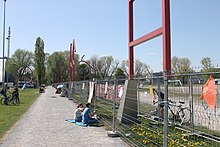Border fence (Constance)
The border fortification between the German-Swiss neighboring cities of Konstanz and Kreuzlingen is called the border fence .
Plant during the "Third Reich"
purpose
The border fence, also known by the population as the Jewish fence or asylum seeker fence, was a border fortification between the Swiss district of Kreuzlingen and the German city of Konstanz, built by Switzerland and National Socialist Germany at the beginning of the Second World War . The fence separated for decades actually coalesced areas and residents and was attended by many residents as a mark of shame felt. The fence was primarily built to prevent the escape of German-born Jews to free Switzerland during World War II. But the escape of German opposition members to neutral Switzerland should also be prevented by the fence. The most famous arrest came on November 8, 1939 at 8:45 p.m. with the arrest of the Hitler assassin Georg Elser directly at the fence. Elser knew the location of the border, but did not know about the new border fence. Elser had lived in Konstanz in 1930 and worked as a cross-border commuter in Bottighofen , Switzerland. At 9:20 p.m. on the same day, his time-detonated bomb exploded in Munich's Bürgerbräukeller .
The first border fence was erected on the basis of a decision by the Swiss Federal Council on October 4, 1939. The fence extended through the inhabited area from the Emmishofer Zoll to the shore of Lake Constance. Almost at the same time, the German Wehrmacht began to erect a fence between Tägermoos and Konstanz from the Seerhein . It was not until 1940 that the entire border between the Seerhein and the Bay of Constance was secured by a high, robust and permanent border fence.
Dismantling
In 1973 the border fence was lengthened again after backfilling in the area of Little Venice near the Bay of Constance. As early as the 1980s, there was massive resistance to the border fence. In 1984 an artist collective with the topic of "art borders" came together in the Bellevue area. In 1990 the construction department of the city of Konstanz demanded: “The fence must go!”. In 1999, the demolition of the fence between undeveloped areas began. This happened as part of the construction of the new motorway customs clearance in Tägermoos .
Today only a few remains are left, primarily in the area of the Konstanz train station and along the Grenzbach. In 2003 the Kulturverband Kreuzlingen organized a cross-border “culture table” at the main customs. Parts of the border fence were replaced in 2006 by the open art border, instead of border fortifications, the border there is marked by sculptures . In 2009 the fence on Wiessenstrasse was removed. A pedestrian crossing was set up. In other places, the height of the fence was significantly reduced. In the area of the border between Tägermoos and the Constance district of Paradies , the fence was replaced by an overgrown earth wall. The original fence has been preserved in other places. It was originally 2.6 kilometers long. Nowadays the border is monitored by the Swiss border guard along the lake shore .
gallery
Temporary rebuilding during the Corona crisis
As part of the border closings to prevent the spread of the corona virus , temporary fences were again erected along the border in March 2020. The first fence was erected by the German Federal Police. Since the distance rules were violated, the city of Kreuzlingen decided to build a second fence to enforce the minimum distance of two meters. In order to enforce the border closure, in addition to the border guard , the Swiss also called in the military. The border was also monitored by a Swiss Army helicopter. Despite the ban on contact, many residents of Kreuzlingen and Konstanz met at the border fence to communicate beyond the fence. The erection of the fence and the tightened controls led to numerous, sometimes violent reactions from the population.
The fence was dismantled on May 16, 2020. Part of this border fence will be kept in the House of History Baden-Württemberg in Stuttgart.
Web links
- Rolf App: Jewish fence, asylum seeker fence. In: St. Galler Tagblatt , September 22, 2012
- The world's first “art frontier” swissinfo.ch, August 17, 2006
- Wolfgang Kramer: History of the district of Konstanz: The border fence ended the freedoms. In: Singener Wochenblatt
- Electricity and barbed wire - a garden fence that separates Germany and Switzerland divides citizens on both sides. Der Spiegel , 38/1990
Individual evidence
- ↑ Georg-Elser-Arbeitskreis-Heidenheim: curriculum vitae
- ↑ Georg-Elser-Arbeitskreis-Heidenheim: The victims of the attack
- ↑ Uwe Moor, Kreuzlingen The history of the border fence, collection of display boards at the main customs of Constance
- ↑ Uwe Moor, Kreuzlingen The history of the border fence, collection of display boards at the main customs of Constance
- ↑ Bernd Kern: Encounters at the border: On Little Venice, people from Constance and Kreuzling must now shake hands through the fence again. In: Südkurier , March 22, 2020, accessed on April 23, 2020.
- ↑ Because of the many meetings at the border fence on Little Venice, the Swiss authorities are putting up a second fence at the art border. Südkurier, April 3, 2020.
- ↑ Love at the border fence in Corona times. swr.de, April 10, 2020.
- ↑ Urs Brüschweiler: cry for help from the Grenzhag: The Kreuzlingen city government asks the Minister of Justice for a special solution for the border region. In: St. Galler Tagblatt , April 8, 2020.
- ↑ www.swr.de
Coordinates: 47 ° 39 '32.8 " N , 9 ° 9' 54.7" E ; CH1903: seven hundred and twenty-nine thousand six hundred ninety-four / 280145







